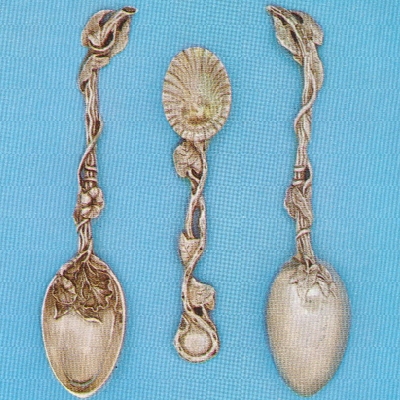Rococo Revival
Rococo Naturalism Revival in 19th century
 Two teaspoons; 1859, Francis Higgins, The stem formed as a twig around which a convolvulus winds, finishing in the bowl with two flowers. 119 mm. This design was shown at the Great Exhibiton of 1851 (Art Journal Illustrated Catalogue, p.26). Sotheby's Belgravia.
Salt spoon; 1835, William Bateman Junior. Convolvulus stem, separately cast, terminating in a gilt flower-shaped bowl. 96 mm. Designed en suite with a salt cellar of 1832 by the same maker, formed as a large convolvulus flower.The nineteenth century naturalistic style, which first became popular in the 1830s, was largely inspired by the Rococo naturalism of the previous century. Unlike the earlier style, however, it often used whole plants and flowers, with little adaptation, as models for vessels or flatware.
Two teaspoons; 1859, Francis Higgins, The stem formed as a twig around which a convolvulus winds, finishing in the bowl with two flowers. 119 mm. This design was shown at the Great Exhibiton of 1851 (Art Journal Illustrated Catalogue, p.26). Sotheby's Belgravia.
Salt spoon; 1835, William Bateman Junior. Convolvulus stem, separately cast, terminating in a gilt flower-shaped bowl. 96 mm. Designed en suite with a salt cellar of 1832 by the same maker, formed as a large convolvulus flower.The nineteenth century naturalistic style, which first became popular in the 1830s, was largely inspired by the Rococo naturalism of the previous century. Unlike the earlier style, however, it often used whole plants and flowers, with little adaptation, as models for vessels or flatware.
The convolvulus was particularly popular, as a writer in the Art Journal of 1849 remarked: 'where else hav e we the same graceful, clinging, affectionate tendril? The spiral bud, the drooping leaf hiding half the beauties of the stem and flower, -the same flower different in every position it assumes, but beautiful in all...what purpose is there in Decorative Art to which its beauties may not be transplanted?'
In flatware this naturalistic treatment was largely limited to dessert services, ladles, and novel types such as caddy spoons. At the 1851 Great Exhibition Francis Higgins showed a cream ladle based on a buttercup plant with gilt flowers, and two caddy spoons, one shaped as a mussel shell, the other as a wild anemone 'copied with as much fidelity as its application to the form of a caddy spoon would permit'. At the Dublin Exhibition two years later he showed a teaspoon similar to those illustrated here but based on the rose.
Naturalism had ceased to be a dominant style by 1860, but it continued in use beyond the end of the century when a number of pieces influenced by Japanese naturalism were made, dating from the late 1860s onwards.
"English Silver Spoons" Michael Snodin
Vine pattern in 19th century
 Left; Ice spade, Vine pattern, 1850, Hunt & Roskell. Silver-gilt. The interior of the bowl smooth, and the front of the stem carrying a blank cartouche. 241 mm. Right; Dessert serving spoon, Vine pattern, 1850, George W. Adams. Silver-gilt with an undecorated bowl. Cast at the top with a Russian coat of arms and on the back with a monogram. 239 mm.Dessert service not based on the common spoon types are extremely rare before about 1770. On such set by Frederick Kandler is already cast and chased with shells, grapes and vine tendrils, in anticipation of similar nineteenth century sets.
Left; Ice spade, Vine pattern, 1850, Hunt & Roskell. Silver-gilt. The interior of the bowl smooth, and the front of the stem carrying a blank cartouche. 241 mm. Right; Dessert serving spoon, Vine pattern, 1850, George W. Adams. Silver-gilt with an undecorated bowl. Cast at the top with a Russian coat of arms and on the back with a monogram. 239 mm.Dessert service not based on the common spoon types are extremely rare before about 1770. On such set by Frederick Kandler is already cast and chased with shells, grapes and vine tendrils, in anticipation of similar nineteenth century sets.
The extensive use of vine pattern (sometimes called Pierced Vine, as here, or Bright Vine when unpierced) began in the first decade of the nineteenth century and was generally confined to dessert sets, teaspoons, and other small spoons. These rather ostentatious serving spoons show how the vine tendrils became less formalized and symmetrical under the influence of naturalism. Particularly interesting is the manner in which the tendrils at the end of the ice spade stem have been shaped as a crown, lending an air of dignity to the initials or crest which would have been added to the blank cartouche beneath. The most showy, and some of the most original, nineteenth century flatware designs were used on dessert services, which were frequently gilt to prevent staining.
Ice spades used for serving and eating ices probably originated in the late-eighteenth century. 'Ice Spoons' appear in the Garrard Ledgers for 1768 and a French ice spade of about 1770 is recorded. Both these servers were made for and used as patterns by the firm of Hunt and Roskell, and the ice spade has consequently not been hall-marked.
"English Silver Spoons" Michael Snodin
 Top
Top Site Map
Site Map References
References About Me
About Me